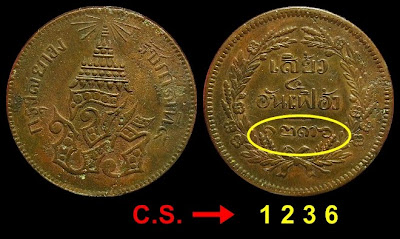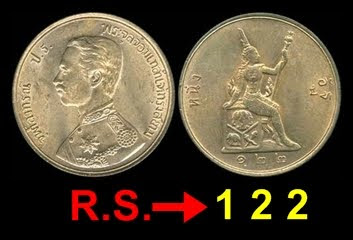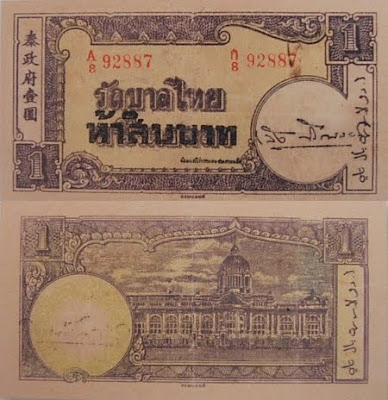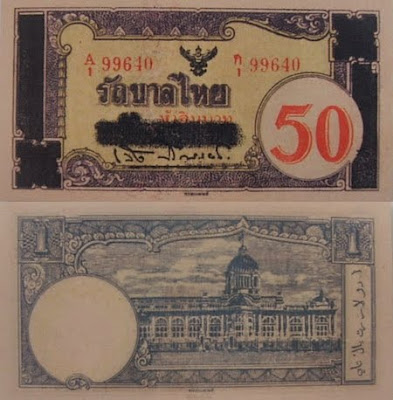skip to main |
skip to sidebar
1,000 Dollars note with two triangles beneath the word GOVERNMENT on reverse is confirmed. Whether there are notes with a single triangle is not known.


Anyone interested in buying these notes can contact Vincent Tan.
In my earlier post Thailand: Series 7 Special - 50 Baht "Mourning" notes, I had talked about 1 Dollar banknotes prepared by Thai government for issue in 4 northern Malay states of Kedah, Kelantan, Perlis, and Terengganu. These notes were never issued but were changed to 50 Baht when Thailand faced a shortage of banknotes in 1945.
Along with the 1 Dollar banknotes, tin coins of 3 denominations were also minted but again never issued due to Japanese opposition.

KM# 5 - 1 Cent; KM# 10 - 5 Cents and KM# 15 - 10 Cents
These "Occupation coins" are rare and extremely expensive. A set of these coins were auctioned by Eur-seree Collecting at 440,000 Baht or approx USD 13,000 in 2006.
After the end of WWII, the Thai government failed in getting Thomas de la Rue to print new banknotes as the printing company had been damaged during the war and was unable to accept new orders. The Thai government thus turned to the U.S. government for assistance. The U.S. Bureau of Engraving and Printing prepared the printing plates and the banknotes were printed by Tudor Press Inc. These series of banknotes were issued late 1946 and early 1947.

Click on above for larger image.
Denominations issued were:
1 Baht : Pick 63
5 Baht : Pick 64
10 Baht : Pick 65
20 Baht : Pick 66, and
100 Baht : Pick 67
These were the last banknotes issued with HM King Rama 8's portrait as he passed away on 9 June 1946. Series 9 banknotes issued from 1948 onwards carried portrait of HM King Bhumibol Adulyadej (Rama 9). Series 9 notes were used for almost 20 years and will take me some time to compile all details like watermarks, serial numbers, etc. to put them in this blog.
In 1943 demand of low value notes increased due to presence of Japanese occupying forces. To prevent further shortage of banknotes, high value of 1000 Baht notes were issued.

Pick 60 & 61: 1000 Baht. Note the red stamp of Bank of Thailand on right of reverse. This stamp was used only for high value notes to detect counterfeits.
Pick 60 (red and yellow shades) was issued in August 1943
Pick 61 (brown and yellow shades) was issued in March 1944
They were taken out of circulation in 1945.
Both notes were printed by the Royal Thai Survey Department using paper produced by Thai Paper Mills at Kanchanaburi province.
This 1 Baht banknote, issued in 1942, was printed by the Royal Thai Survey Department using domestic materials. Hence the poor paper and print quality. Since these banknotes looked similar to fake notes burnt during Chinese funerals, they were called "Kongtek" (กงเต๊ก) notes.
They are now very difficult to find in good condition.

Pick 58a: 1 Baht
10 Baht banknotes printed by the occupying Japanese in Indonesia were stolen during transport to Bangkok, Thailand. After declaring them illegal, the Thai government decided to overprint the remaining notes with a value of 50 Satang.

Pick 62: 50 Satang on 10 Baht (Click above to see larger size image)



























